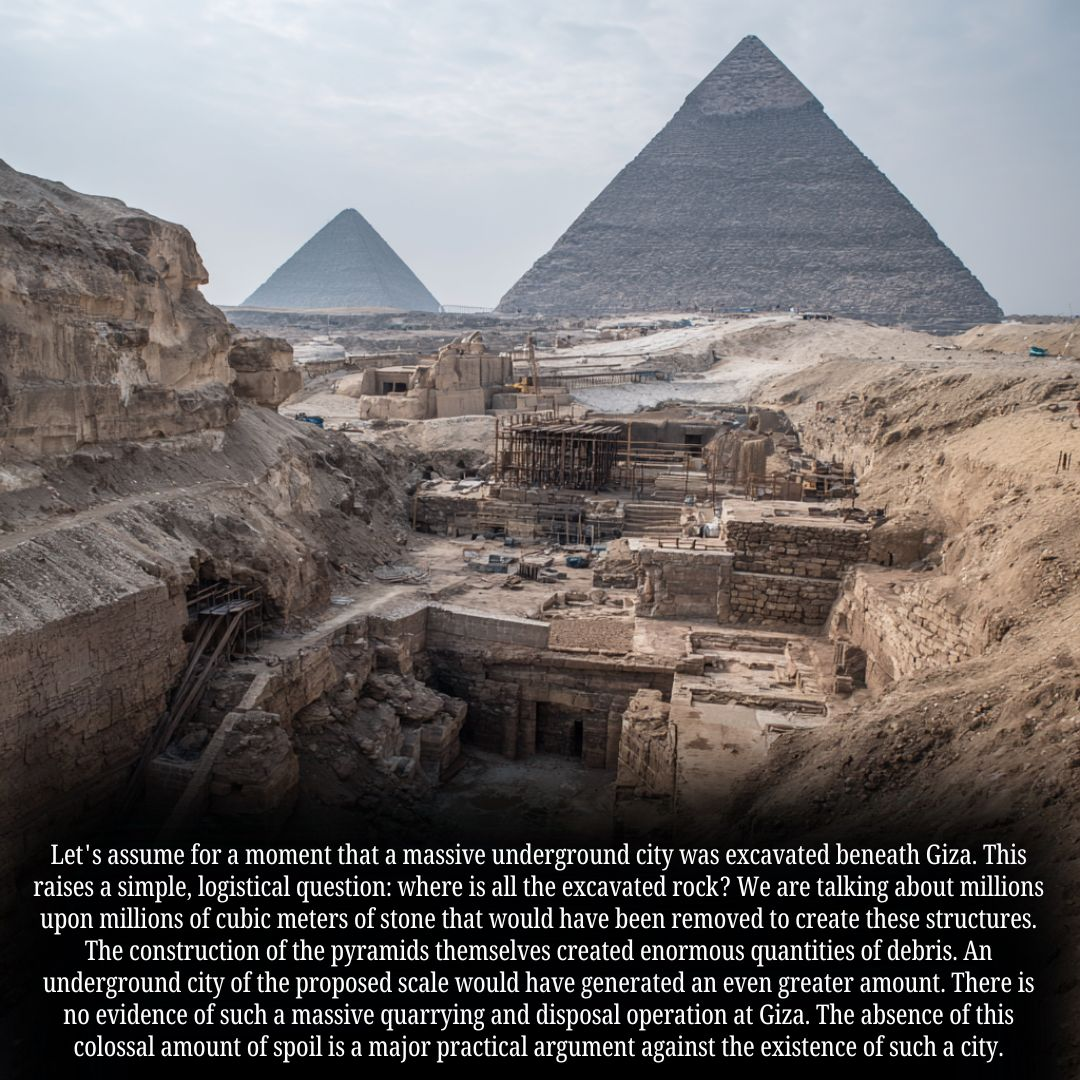
We tend to romanticize lost cities.
In whispered legends, they vanish without a trace—consumed by sand, swallowed by seas, or buried beneath layers of history. Atlantis. Shambhala. Zerzura. Names that stir the imagination because they promise that something extraordinary still sleeps beneath our feet. Giza, with its pyramids and monuments bathed in desert light, has long been a canvas for such dreams. But for all the stories of chambers beneath the sand and hidden civilizations beneath the stone, one question echoes louder than most:
Where is the debris?
If there truly is a city beneath Giza—a labyrinthine expanse carved deep into the earth, rivaling the pyramids in scope—then it would have left behind something unmistakable. Not a structure. Not a tomb. But a mountain.
The Silence of Spoil
Excavation is never clean. For every chamber built underground, there must be spoil—earth, gravel, dust, stone—dragged out, heaped up, or hauled away. It’s a fundamental law of digging: you can’t hollow out the ground without leaving a scar somewhere. Just look at the Great Pyramids themselves.
The construction of Khufu’s pyramid required the movement of over 2.3 million blocks, each weighing an average of 2.5 tons. Quarry sites remain visible to this day, the mᴀssive scars in the Giza Plateau testimony to an operation of staggering scale. And yet, if we’re to believe some fringe theories, a vast subterranean city also exists here—one that would have required the removal of millions more cubic meters of stone, far beyond what the pyramids themselves demanded.
So where is all that displaced rock?
There are no nearby spoil heaps of the necessary scale. No secondary quarries with signs of waste disposal. No evidence of the transport systems that would have been needed to remove and disperse the spoil. In short: no trace of the mess such an undertaking would have left behind.
That’s not just an oversight. It’s a gaping absence. And in archaeology, absence can be louder than presence.
What We Know, and What We Want to Believe
It’s important to distinguish between what’s unknown and what’s unknowable. There are, undeniably, unexplored spaces beneath the Giza Plateau. Ground-penetrating radar and seismic surveys have revealed voids—some large enough to be chambers, others small and fragmented. These findings, intriguing as they are, do not support the existence of a sprawling underground metropolis. At best, they hint at rooms, tunnels, or perhaps ceremonial structures lost to time.
But even those would have required spoil removal. The ancient Egyptians were methodical. Every project left evidence: broken tools, chisel marks, debris piles, access ramps. The pyramids are not just marvels of precision—they are echoes of labor, of planning, of logistics. Their construction was as much about managing material as it was about elevating stone.
If a second monumental project existed beneath the ground, it would have required an even greater logistical footprint. We should see signs: spoil mounds, waste channels, perhaps even causeways leading to dumping grounds. But there is nothing. Not in the desert west of the plateau, not buried beneath secondary structures. Nothing on the scale required.
Could It Be Hidden?
Some speculate that the debris from such a city was used to build the pyramids themselves. It’s a clever theory—but flawed.
The quality of limestone and granite used in the pyramids was carefully chosen. Blocks were sourced from quarries miles away, not randomly gathered from spoil. Reused debris would have been inconsistent in size and integrity—not ideal for megastructures intended to last forever. Furthermore, the timelines don’t match. To build the pyramids with the spoil from an underground city, that city would have to predate the pyramids themselves, implying a civilization even older than dynastic Egypt.
That brings us into the realm of speculative prehistory—fun to imagine, hard to prove.
And again, if such a civilization existed, they too would have left waste. Every quarry is a wound in the land. Even the polished tools of time cannot erase that much stone being moved.
Stone, Sand, and the Struggles of Proof
Giza is often thought of as eternal. But it has changed. Erosion, earthquakes, urban expansion—all have shaped the plateau. Could spoil have been eroded, hidden, reburied over the centuries?
Possible. But again, scale matters.
We’re not talking about modest trenches. We’re talking millions of tons of excavated material. Even wind cannot move that quietly. Even time cannot swallow that completely. In archaeological contexts, mᴀssive spoil heaps can remain legible for thousands of years. The quarries of Luxor, the rock waste of Petra, the leftover scars of the Inca—all are still visible today.
To accept that all spoil from a Giza “underworld” simply vanished is to accept a vanishing act greater than any structure the ancients ever built.
The Beauty of Limits
This is not to say that the Giza Plateau is devoid of mystery. Far from it. Every year, new discoveries are made: hidden shafts, unexplored tombs, intricately carved reliefs tucked beneath the sand. The site remains alive, evolving with every spade of earth moved and every laser scan analyzed.
And perhaps, just perhaps, there are still chambers yet to be found—but smaller ones. Forgotten by history, tucked into the dry rock layers above the water table, filled not with gods but with scribes, engineers, priests. These, too, are worth dreaming about. They do not need to be cities to be extraordinary.
In truth, we may honor the ancients more by accepting the limits of what they achieved than by inventing what they never did. The pyramids themselves are miracles. They do not need to sit atop something even grander to inspire awe.
The Human Cost of Imagination
Still, we can’t help but wonder.
Maybe that’s the point. Maybe the reason people invent cities beneath the pyramids is because the pyramids themselves feel like only part of the story. Their silence is too complete. Their perfection too strange. We want there to be more—not just because we crave mystery, but because we long for connection. A link to a past so powerful it still moves us 4,500 years later.
And so we dream downward. Into the stone. Into the absence. Into the places where we think the truth might still be hiding.
But sometimes, absence is the truth.
Sometimes, the question “where is the debris?” is enough to pull us back from fantasy, into the solid, chiseled clarity of archaeology.
Still… The Desert Waits
And yet, the sands keep their secrets. And Giza—majestic, solemn, unknowable—still watches us from across the ages. The Sphinx stares westward. The pyramids cast their shadows. And beneath them lies not a city, but questions.
Who built these wonders?
Why here?
Why like this?
And is it possible that the most astonishing story was always hiding in plain sight—not beneath the ground, but in our stubborn refusal to believe that what we already see could be enough?
Conclusion: In Stone, In Silence
The pyramids stand not just as tombs, not just as monuments—but as metaphors. We build myths beneath them because we think such majesty must have deeper meaning. We want tunnels and vaults, kings and secrets.
But what they offer instead is something quieter. A story of sweat, vision, and stone. A story that left behind exactly what it needed to:
Not debris.
But wonder.


